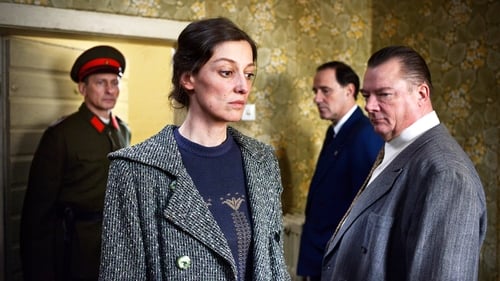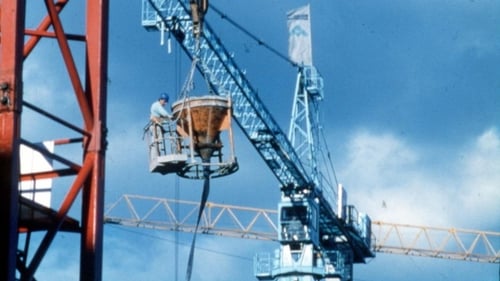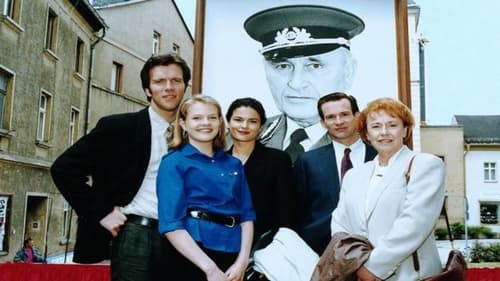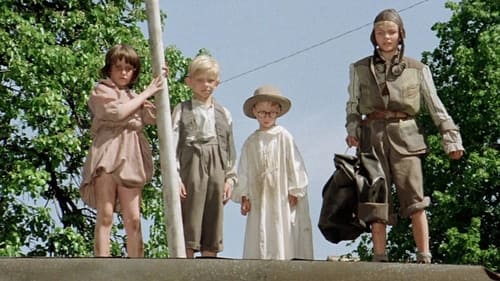
Camera Operator
Sven Marquardt might be the most famous bouncer worldwide. But beside standing in front of the legendary techno club Berghain in Berlin, he is also a well-known and skilled photographer. Long before the Berlin Wall came down, Marquardt portrayed the subcultural East-Berlin scene. His black and white photography illustrates it as voluptuous, laid-back, dirty and existential. Even if shot by daylight, his work is permeated by darkness, ecstasy and night.

Cinematography
A German communist wrongly accused and sent to a labour camp has to keep her past life hidden for the sake of her and her family’s freedom.

Cinematography
Director Annekatrin Hendel delivers a portrait of three generations of Brasches as a microcosm of societal tensions being carried out on a large scale — between East and West, art and politics, communism and religion, love and betrayal, utopia and self-destruction.

Director of Photography
Beyond Boundaries is a lyrical, essay-like road movie tracing the scars of war in Europe and telling of places where a border is known as “Meja”, “Granica”, “Határ” or “Frontiera” – the borders of Slovenia to Austria, Croatia, Hungary, and Italy.

Cinematography

Cinematography
Volker Koepp revisits locations and people from his earlier documentaries in the wide Eastern European region of Sarmatia.

Himself
Documentary about poet Sascha Anderson.

Cinematography
Documentary by Volker Koepp.

Cinematography
In his film "Berlin-Stettin", well-known documentary film director Volker Koepp embarks on a journey to the places of his own past: Born in 1944 in Stettin (now the Polish city of Szczecin) and grown up in Berlin-Karlshorst, Koepp has again and again met people and found places located between the two cities that he turned into the protagonists of his films – in Brandenburg, in Mecklenburg, and in Pomerania. Now, he once again returns to these places and finds out that his own biography overlaps with the biographies of his found again protagonists as well as with the history of this region. During his search for traces, Koepp at the same time finds new people, new regions, and new themes that are also worth becoming a part of Koepp′s narration.

Cinematography
Documentary about the region next to the river Memel.

Camera Operator
In 1984, the “First Leipzig Autumn Salon” took place – a risk and a caesura for Dammbeck. Bypassing every state institution, six painters, sculptors and filmmakers organised an art exhibition. It was the first and last of its kind. This recapture of public space through art challenged the government’s monopoly on power and triggered similar activities by other artists in the art centres of the GDR. A brave signal to the SED who saw this exhibition as a “counter-revolutionary development”. After that, there were only two options: regress or leave.

Director of Photography
Estação de Santamaria à noite. Ossorio, homem dos seus quarenta anos, sai de um comboio, por entre uma multidão de refugiados e de soldados derreados. É numa cidade sitiada que este herói de uma resistência em fuga tenta reencontrar os seus antigos aliados e aquela que ama. Mas a situação agora é outra, e os amigos de ontem já não têm o mesmo discurso. Enquanto uma milícia desenfreada aterroriza a cidade, cada um só quer é salvar a própria vida.

Cinematography
The film tells the story of the East Prussian landscape and its inhabitants. At one time Germans, Poles, Lithuanians and Jews lived here alongside and with one another. After World War II and the expulsion of Germans by Stalin, the Prussian province turned into a Russian enclave. Volker Koepp’s fourth film about the Kaliningrad region is dedicated to the generation, born in the '90s, and familiar with the Soviet Union and East Prussia only from school books. Parents and grandparents who were forcefully resettled to where they are now have never really felt at home. In the meantime they have hopelessly succumbed to unemployment and alcohol. Their children can only rely on themselves. Older siblings look after the younger ones, they play with what lies around, and the girl Ljuda can’t wait to finally turn eighteen, to be able to take her brothers home from the orphanage. The film has much confidence in the children. But what will become of them?

Cinematography
Documentary by Volker Koepp.

Director of Photography
Hilde Reimer is overjoyed when her three grown-up daughters and their partners move into the old family villa. The only thing that really bothers Hilde is that her three girls are still not married, despite having children and being very much in love.

Cinematography
A documentary about Masuria, a province in the northeast of Poland, which is probably the most renowned part of former East-Prussia. Albeit a recent boom in tourism, the sparsely populated region still remains one of the poorest regions in Europe. The impressively photographed film reflects upon the eventful history of this land: It portrays farmers, who struggle to work the barren land; fishermen, who fight for their existence, and Ukrainians, who were once forced to relocate and now return to their old home in the East.

Cinematography
In his documentary film, Volker Koepp portrays the picturesque Polish region of Pomerania. But although the region appears to be idyllic, its inhabitants are struggling with big problems. The villages and cities of Pomerania that traditionally live from agriculture are hit by unemployment rates of up to 75% after the meltdown of the state farms. While most of the young people leave the region, some of them take their chances and start fresh – for instance, a young couple that tries to rebuild an agricultural farm with the help of EU funding. Furthermore, older inhabitants, including a spry 90-year old retiree from the Uckermark region who grew up in Pomerania, tell stories about the region′s eventful past.

Cinematography
Czernowitz, an out-of-the-way city in the middle of Europe. It was once part of the Austro-Hungarian monarchy as the capital of the crown province of Bukowina. People of many different nationalities, languages, and cultures lived here together: Ukrainians, Romanians, Germans, Poles, Huzulians. Almost half of the population of Czernowitz, once amounting to 150,000 inhabitants, were Jews. The southern part of Bukowina is now part of Romania, the north, with Czernowitz/Chernivtsi, belongs to the Ukraine. Six years ago Volker Koepp made his film Herr Zwilling und Frau Zuckermann there. Dieses Jahr in Czernowitz returns there with emigrants and their descendants.

Cinematography
Volker Koepp returns to the Brandenburg Marches, where many of his films were made. Uckermark describes the coexistence of the various eras using the stories and lives of the local people. They are farmers and returning noblemen, men and women hoping that short-term job-creation schemes will lead to meaningful work, a theatre director whom the Uckermark reminds of the past.

Cinematography
Documentary film by Helke Misselwitz.

Cinematography
A documentary focusing on the rebuilding projects in Berlin after the fall of the Berlin Wall.

Director of Photography
After Sam, a penniless Afro-German singer, discovers he's HIV positive, he gets utterly drunk, spends a few miserable days, but promptly falls (back) in love. Amidst a crumbling former East Berlin (its bulidings, cars, people & culture), Sam develops a "family" for the new millenium, for the new generation of post-drug cocktail AIDS victims. The fragile "family" he forms includes his on-again-off-again boyfriend Rainer, and his best friend Bastl with his latest fling, Mike. Like the old, schmaltzy East German songs which Sam is recording, the sweet innocence of the characters struggle to prevail, the misfortunes of the characters nothwithstanding.

Cinematography
The "Curonian Spit" is a 98 kilometre long sand dune peninsula that separates the Curonian Lagoon from the Baltic Sea. The width of the spit between the lagoon′s beach and the beach of the Baltic Sea often amounts to no more than several hundred metres. In this film, documentary filmmaker Volker Koepp portrays this unique region that in its history was again and again subjected to shifting borders and the resulting social upheavals due to its geographical location between Germany and Russia.

Cinematography
In the west of Ukraine, not far from the border to Romania, there is a faraway European city: Czernowitz. It was once the centre of Jewish culture in the Bukowina, a border area characterized over centuries by a multi-cultural mixture of peoples. Here, Ukrainians, Poles, Romanians, Germans and Jews lived side by side.
Volker Koepp’s film focuses on Mr. Zwilling and Mrs. Zuckermann, two of the last few Jews born in the old Czernowitz. They share a friendship but also their love for the German language. Mr. Zwilling visits 90-year-old Mrs. Zuckermann daily in the early hours of the evening. They talk about old times, about shared events, about politics and literature and the worries of everyday life.

Camera Operator
At the Vienna Art Academy in 1994, an unidentified person painted over 27 works by Austrian painter Arnulf Rainer. Rainer had become world-famous for his abstract art and, in particular, for his over-layering of photographs and overpainting of his own and other artists’ works. But who painted over the “overpainter”? Speculation rages: Did he attack his works himself? A year later, an unsigned letter surfaces claiming responsibility for the act directed against Rainer – and modern art in general – and accusing the artist of being complicit with “destructive modernism.” At the same time, Austria is shaken by a series of mail bombs by the Bajuwarian Liberation Army, in response to the supposed threat to Austria’s “German identity.” Are there connections between the overpainting event and the mail bombs? Or is this all just a game? A dream? Or perhaps a hallucination?

Cinematography

Cinematography
Ramona lives her lonely life in Berlin working in a lipstick factory. One day she accidentally runs into Andrzei, a Polish mechanic illegally selling cigarettes in Germany during the weekend. One thing leads to another, and soon she finds herself pregnant. Then her life starts falling apart, when Andrzei tells her he already has a wife back in Poland and her baby dies shortly after its premature birth.

Camera Operator
Dammbeck, himself an alumnus of the Leipzig Academy for Graphic and Book Design, presents the origins of the new German realism developed by the so-called Leipzig School, which took place in the context of socialist-realist dogma in the GDR before the Wall was built in 1961. After the Wall came down in 1989, what happened to the major Leipzig School painters Werner Tübke and Bernhard Heisig, who had been called “Dürer’s red heirs” by West German journalists in the 1970s? In the film, Tübke, Heisig, and former GDR officials who were involved with the cultural scene in Leipzig at the time talk about modernism, conformism, political pressure, party discipline, personal claims, and fading memory. The documentary paints an insightful, often critical picture of early East German art history.

Cinematography
Documentary film by Helke Misselwitz.

Director of Photography

Cinematography
In this documentary Volker Koepp shows part of the history of Prussia. He begins 700 years ago with the land of the Pruzzen situated between the rivers Weichsel and Memel and proceeds the development of the state.

Cinematography
Documentary about the impact of uranium mining in East Germany.

Cinematography
In the little town of Herzsprung - whose name harks back to an ancient legend of broken hearts - almost nothing has changed since German unification, except a rise in unemployment. Johanna, a young mother and widow, becomes one of the unemployed and lives on welfare. To make matters worse, she falls in love with a dark-skinned, roving adventurer and the whole village starts talking about it.

Camera Operator
The film explores what transformations in power and politics do to art, how much opportunism can be found in “pure” art and whether fascist symbols can ever regain their aesthetic innocence. The questions it addresses about the relationship between ethics and aesthetics make a valuable contribution to any discussion about art and power.

Cinematography
A teacher at a German high-school in the nineteen thirties has issues with his students who seem to be getting less human and more convinced of Nazi ideals as time goes on.

Director of Photography
In late 1990 times are changing in Zehdenick, Brandenburg: Russian troops are leaving, the German Reunification brings euphoria and new hope, but unemployment rises steadily.

Director of Photography
In early summer 1989, Helke Misselwitz portrays young musicians in a band who produce their music on other people’s waste items. The four boys call themselves "Bulk Rubbish" and they drum out their resentment, having grown up on the new housing estates of East Berlin. A straight-up picture of the GDR youth is presented here, which in no way conforms to the official image. The film crew concentrates on the observation of the boy Enrico and his mother Erika: when the mother marries in the West, her son decides to stay in East Berlin, bidding her farewell at the border-crossing. Only shortly after, the tables are turned again: as the events in Berlin leading up to the fall of the Wall are practically captured live from the film crew, Enrico insists on maintaining his cultural identity, even after the fall of the Wall. The "Bulk Rubbish" musicians want to remain citizens of their own state and perceive the looming reunification with scepticism.

Director of Photography
Volker Koepp revisits Zehdenick and Grüneberg, East Germany. People are struggling with the new political and economical conditions shortly before the German Reunification.

Cinematography
In a loose set of cabaret pieces, Steffen Mensching and Hans-Eckardt Wenzel - highly acclaimed East German poets, songwriters and clowns - satirize East German life in its final days and the arrival of new times after the fall of the Berlin Wall. The clowns are allowed to leave prison to sing for people outside. As they perform their pieces, however, the country sinks into rebellion, the prison is attacked and looted, and the people chase the clowns away. Latest from the Da-Da-R was the first film made by an artistic production group that had fought for independence within the structures of the state-owned DEFA film studio for years. "Da-Da-R" is a wordplay on the irreverent Dada art movement of the 1920s and the German acronym for East Germany- the DDR.

Cinematography
A documentary about the deconstruction of the Berlin Wall which makes no use of vocal commentary but instead focuses on visual elements. From the Potsdamer Platz to the Brandenburg Gate, the camera captures the historic events from all sides and different angles: on the one hand there are news reporters and tourists from all over the world taking pictures, children selling pieces of the wall to passers-by, and people celebrating New Year's Eve, on the other we see abandoned subway stations and officials with blank looks on their faces.

Cinematography
Only two months after the fall of the Berlin Wall, in January 1990, almost two hundred controversial East German visual and performance artists—including Jürgen Böttcher, the Autoperforation Artists, AG Geige, Via Lewandowsky, Trak Wendisch, Conny Hege, Klaus Killisch, Helga Paris and Hanns Schimansky—presented works rarely shown in the GDR at the exhibition space in the former La Villette slaughterhouses on the outskirts of Paris.

Cinematography

Writer
Portrait of a private coal company in East Berlin's Prenzlauer Berg district in 1988/89. The feisty woman boss runs the business with humour and understanding. Her seven male employees respect her. To the outside world, they are all tough guys, but as they describe their jobs and personal situations, above and beyond the hard manual labour, their vulnerability starts to come to light.

Director of Photography
Portrait of a private coal company in East Berlin's Prenzlauer Berg district in 1988/89. The feisty woman boss runs the business with humour and understanding. Her seven male employees respect her. To the outside world, they are all tough guys, but as they describe their jobs and personal situations, above and beyond the hard manual labour, their vulnerability starts to come to light.

Director of Photography
Documentary filmmaker Volker Koepp visits a brick factory in Zehdenick, East Germany.

Cinematography
A journey from the North to the South during the last year of the GDR. Laborers and puny girls, mothers, intellectuals, young and old are being interviewed about humanity, they criticize and give hope. They are strong and self confident women who have to eke out a living but still smilingly tell of a world full of contradictions. Awards: Silver Dove, Leipzig 1988.

Writer
A journey from the North to the South during the last year of the GDR. Laborers and puny girls, mothers, intellectuals, young and old are being interviewed about humanity, they criticize and give hope. They are strong and self confident women who have to eke out a living but still smilingly tell of a world full of contradictions. Awards: Silver Dove, Leipzig 1988.

Cinematography
Two men sit on the top of a roof, playing the tuba. They continually call out absurd messages making fun of official solutions and of their own slogans. The residents feel disturbed by the tuba's sound and start to attack the musicians, while they themselves keep on playing and shouting louder and louder. Finally the house is blasted and the tubas are destroyed.

Director of Photography
Volker Koepp documents life in the Dorotheenstadt in Berlin-Mitte, which was called "Feuerland" in the 19th century.

Director of Photography
In 1987, a Berlin couple hits the small stage with rock'n'roll - petticoat, stripped socks, ducktail and all. A laid-back study of a GDR slice of life.

Cinematography
The interviews conducted by Tamara Trampe in a Pankow kindergarten testify to a rare attempt to enter the world of the young interviewees completely, to give their stories a space where reality and fantasy, worries and wishes can mix freely. A space that’s not always provided in the daily life of the kindergarten, as the film casually suggests even after it was toned down by the DEFA censors: toilets without doors, ghastly birthday parties and friendly but unmistakable reprimands when the children let too much dialect slip into the grammar exercise or when their pictures of soldiers are not realistic enough.

Director of Photography
This documentary follows a group of women on a typical workday as they prepare meals for a dockyard in Rostock. The viewer never learns their names - there are no interviews. The women are presented simply as workers: cooking, cleaning, hauling, and serving dishes amid clanking pots and hot steam.

Cinematography
For five years Rogelio, a Chilean exile, has been in the GDR, where he works as a lighting technician at a theater. Though his colleagues try to make him feel welcome, he feels lonely and isolated.

Director of Photography
A shunter's job is to slow down, link, and unlink train wagons at a central station. The film documents - without any commentary - the working hours of few shunters at the shunting-station Dresden-Friedrichstadt, which was the largest such station in all of the former German Democratic Republic. They work day and night, amidst snow and fog at the railway tracks, speaking only as much as necessary.

Cinematography
After a hot and steamy company party, Sibylle and Harald, both in their late thirties, spend the night together. He is a widower with two sons, with the younger son just entering school. She is single and relatively satisfied in her current relationship with a married colleague. When they meet again later, they resolve to enter into a strictly intellectual relationship.

This children's adventure movie is a charming tale of a group of youngsters in Prague who hear that Soviet sailors abandoned their failing ship in the Arctic Sea before it went down, but no one had been able to find the sailors yet. Inspired by the efforts to save the men, the youngsters strike out on their own to help in the rescue attempt.

Director of Photography
Inge Herold is in her mid-thirties. She is divorced and lives with her 15-year-old son. She works as a psychologist and social worker and is involved with a married man. Suddenly, Inge finds out she may have breast cancer, which would mean an operation the very next day. The 24 hours before the planned surgery puts her under enormous psychological pressure and she begins to reevaluate her life. With heightened awareness of matters of everyday life, she realizes that what she previously considered meaningful, was actually void of any real meaning.

Cinematography

Cinematography
Young people living in a children’s home in Mecklenburg talk about their unstable home situations and domestic violence. Many of them have alcoholic parents and some are in danger of going down the same path. They speak openly about the past and their hopes for a better life. The documentary follows the young men and women within the group and in search of personal space. A party to start the summer holidays marks not only the end of the school year – it also means that an entire class will be taking leave of the home forever.

Cinematography
Sculptor Makolies is filmed working on a sculpture in the middle of a quarry in Swiss Saxony. The quarry workers go about their work around him. Both the work in the quarry and the work on the large figure in sandstone require strenght and conscientiousness. This film observers both types of work, without comparing them.















































